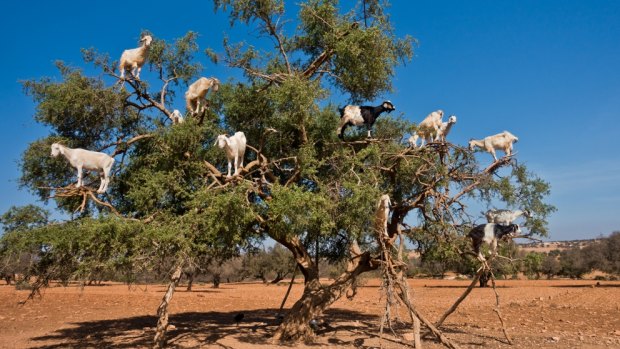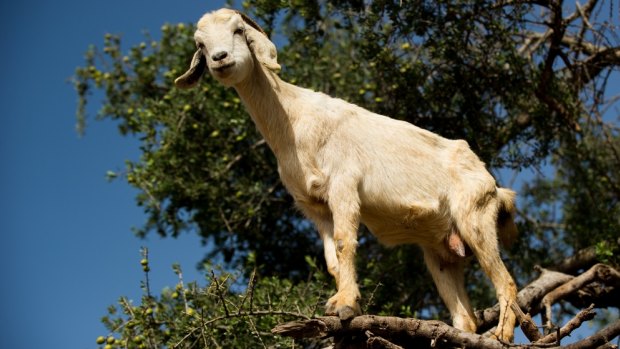This was published 5 years ago
Iconic 'tree-climbing' goats of Morocco revealed to be a scam
By Raf Sanchez

Tourists are charged to take photos of the goats.Credit: Shutterstock
Visitors to Morocco have long flocked to the roads outside Marrakech to take photographs of the goats that climb into the low boughs of the Argania tree in search of its sweet fruit.
Such pictures are widely shared on social media and often decorate the pages of guide books to Morocco.
But an investigation by Aaron Gekoski, a British environmental photojournalist, has uncovered that the tourist destination seems to be an exploitative scam.

The goats are often rotated halfway through the day as they get tired.Credit: Shutterstock
Local farmers appear to be bringing the goats in from other areas and forcing them into the trees before charging tourists to take photographs of them.
When the goats eventually tire from balancing on the tree branches they are brought down and new goats are substituted.
Mr Gekoski said: "After seeing tourists' interest in the tree-dwelling goats, some farmers decided to manipulate the situation for financial gain.
"I heard they even brought goats in from other areas, built platforms in the trees and now cajole the goats into the trees, charging tourists to take photographs.
"They will take the goats home in the late afternoon, before coaxing them back into the trees at sunrise.
"The goats are incredibly nimble when it comes to navigating the trees, though generally they just stand in one place, looking rather sick and forlorn.
"All the tourists who visited seemed blissfully unaware though and 'oohed' and 'ahhed' before taking photos and selfies."
Mr Gekoski has hosted various environmental television programmes and is currently working on a campaign to end cruel wildlife tourism attractions. The Morocco investigation was part of that work.
He said: "The goats are often rotated halfway through the day as they get tired. It's incredibly hot work standing in a tree all day and generally the goats are in poor condition and very skinny."
Dr Chris Draper, head of animal welfare and captivity at the Born Free Foundation, said: "Images of goats in trees have become iconic, suggesting a rural idyll where crafty and agile animals have learned to make the most of their environment.
"Sadly, the reality seems to be that this is anything but natural, and is instead an exploitative set-up, designed to snare unsuspecting tourists to pay to take pictures.
"The animals are unable or unwilling to move from where they are placed in the trees by people.
"This means that they will be unable to move into shade or to forage in a normal manner.
"The situation is likely to be very stressful for the goats, made worse by being placed next to a busy road and with streams of visitors stopping to take a look.
"This is just one of several issues of which we are aware in Morocco where animals are being abused to cater for a demand and provide photo opportunities for tourists."
The Telegraph, London
See also: The truth about the posing gorillas in ranger's viral selfie
See also: Popular Indonesian island destination will close to tourists in 2020
Sign up for the Traveller Deals newsletter
Get exclusive travel deals delivered straight to your inbox. Sign up now.